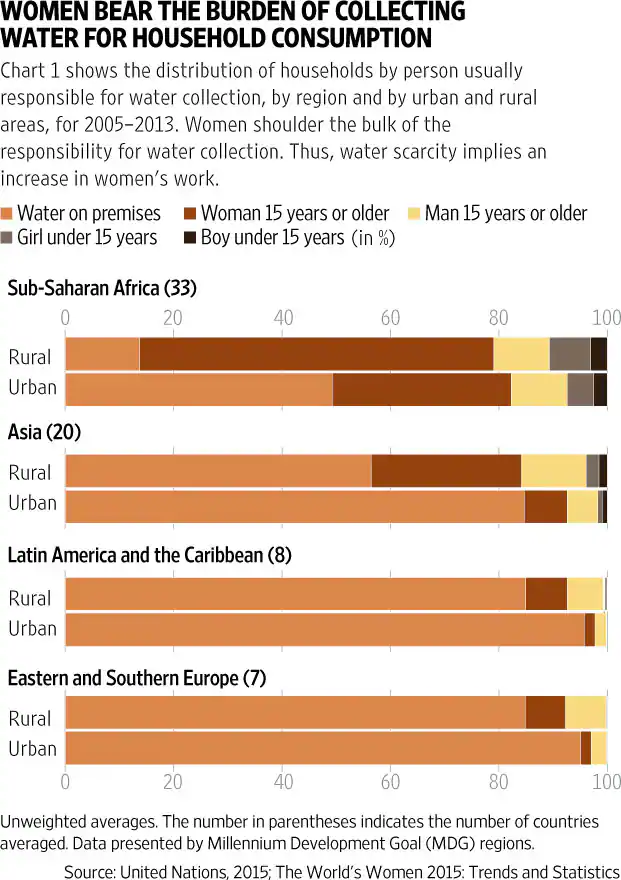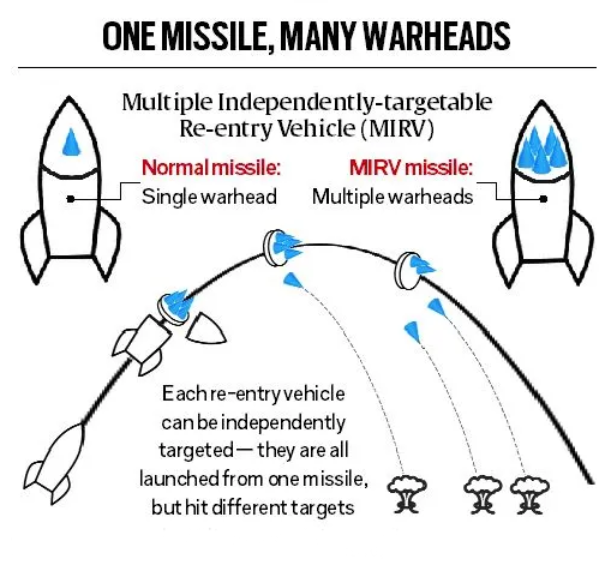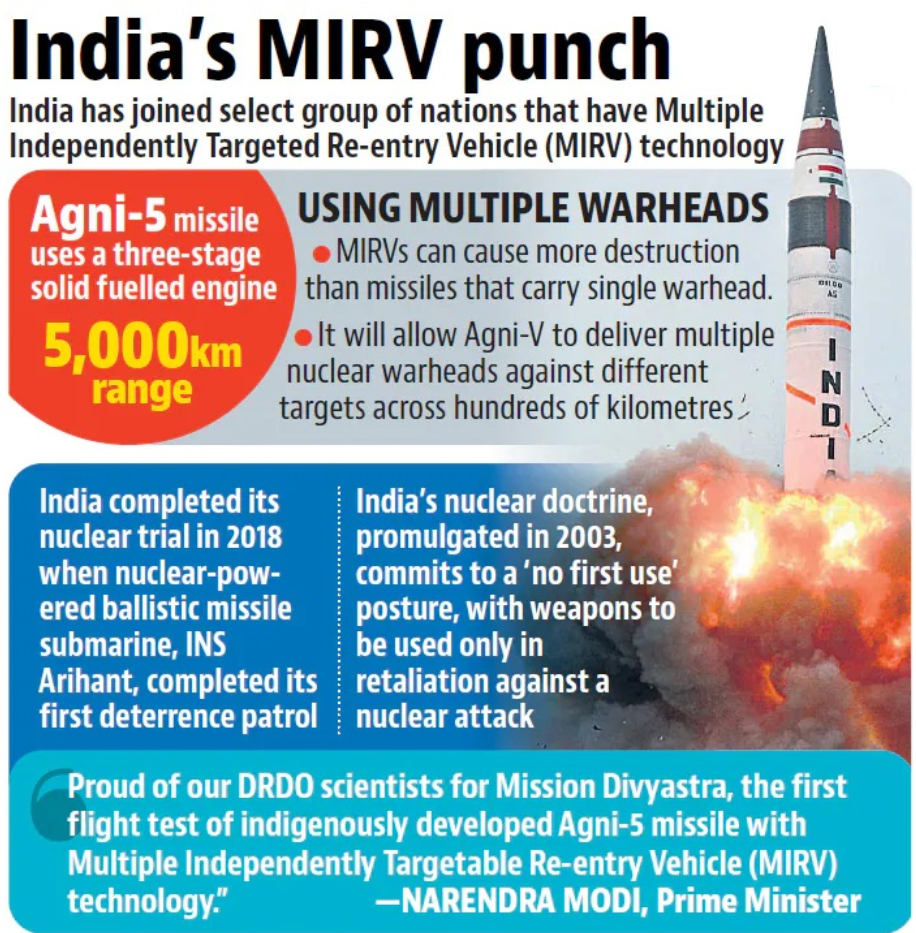CONTENTS
- World Water Day and Women
- Multiple Independently Targetable Re-Entry Vehicle (MIRV) Technology
World Water Day and Women
Context:
Despite significant strides in expanding access to water in households across India, findings from the National Sample Survey 78th round multiple indicator survey (2020-21) reveal that more than 41% of rural households still lack access to safely managed drinking water within their homes. Moreover, there are persistent geographical disparities in household access to safe water, albeit decreasing over time.
Relevance:
GS2-
Issues Related to Women
GS3-
- Water Resources
- Conservation of Resources
Mains Question:
The theme for this year’s World Water Day is ‘Water for Peace’. In this context, discuss why water insecurity affects women more than men. How efficient have government schemes been in this regard? (15 Marks, 250 Words).
Relevant Statistics:
- Many households rely on principal water sources located at distances ranging from 0.2 to 1.5 kilometers or even farther.
- Despite being home to 18% of the world’s population, India possesses less than 5% of global water resources.
- A report by the National Commission for Women reveals that a rural woman in Rajasthan covers a distance of more than 2.5 kilometers to access a water source.
- Furthermore, according to a non-profit organization called Water, women globally dedicate a combined total of 200 million hours to collecting water.
- Additionally, many spend substantial time searching for suitable locations to attend to their sanitation needs, resulting in an additional loss of 266 million hours daily.
Water Insecurity and Women:
Women’s Vulnerability:
- The water crisis exacerbates the vulnerability of women, who have traditionally been burdened with the responsibility of fetching water in India for centuries.
- Particularly in rural areas, women traverse long distances to fetch water from the nearest source.
Diminished Access to Sanitation:
Their marginalization is further compounded by the lack of access to private facilities for fulfilling their sanitation needs, leading to indignity and insecurity.
Time Constraints:
The expectation for women to carry out water-fetching duties leaves them with limited time for themselves, resulting in reduced access to clean sanitation and poorer physical and mental health outcomes.
Concept of “Water-Wives”:
In one drought-prone village in Maharashtra, the entire water management being handled by women has led to a phenomenon known as “water-wives,” where individuals have multiple spouses tasked with collecting water. This practice reflects regressive attitudes, viewing women as mere substitutes for water infrastructure like pipes or tankers.

Other Consequences:
- Research indicates that the absence of water access can lead to significant stress among households. In regions with water scarcity or where households depend on sources outside their premises, water collection is often viewed as a gendered task, with women and girls bearing the burden of fetching water, impacting their daily lives, household dynamics, and social interactions.
- Moreover, water insecurity adversely affects girls’ school attendance and academic performance. Women also face gender-based violence during their journeys to collect water, exacerbating the strain on their mental health.
- Studies indicate that the absence of adequate water access contributes to the prevalence of open defecation, which, in turn, has various repercussions for women.
- Apart from health implications such as diarrhea, typhoid, and cholera, as well as impacts on menstrual health, women engaging in open defecation also experience psychosocial stress and an increased vulnerability to non-partner sexual violence.
Jal Jeevan Mission (JJM) and the National Water Mission:
- The Jal Jeevan Mission (JJM) and the National Water Mission signify a significant shift in water management policy. The JJM aims to provide access to drinking water through household tap connections, reducing the burden on women and allowing them more time for productive activities.
- The initiative endeavors to gauge this impact by promoting greater participation of women in community activities, including those related to gram panchayats and self-help groups.
- To this end, the program focuses on empowering women by encouraging their involvement in Pani Samitis formed for planning, implementing, operating, maintaining, and monitoring the program at the village level.
- JJM guidelines also advocate for the training of at least five women from each village in periodic water quality monitoring.
- This serves a dual purpose of empowering these women while ensuring the provision of quality water to all rural households under the program.
- In a recent study conducted in rural areas across three districts in Tamil Nadu, the findings indicate that household access to safe drinking water facilitated by the JJM results in a reduction in the time spent collecting water from off-site sources.
- This, in turn, allows women to allocate more time to managing household tasks, supporting their children’s schooling, and childcare responsibilities.
- Women who scored higher on overall empowerment indicators also spent less time fetching water and exhibited better mental health indices. Additionally, the study revealed positive associations between access to water and access to sanitation.
Way Forward:
- Addressing the water, sanitation, and hygiene needs of women is crucial for promoting gender equity and unlocking the potential of half of the world’s population. The water crisis is inherently a women’s issue, and it is imperative for feminists to engage in discussions surrounding it.
- To prevent contamination by river water, it is essential to meticulously monitor the water levels of floodplain aquifers, ensuring they remain well above the level of the river water.
- Floodplains can be protected by planting organic food forests or fruit forests, which require minimal water consumption and help secure the area against flooding.
- In water management, corporations should take a more proactive approach by utilizing their Corporate Social Responsibility (CSR) initiatives to innovate and conserve water, as well as facilitate water recharge efforts.
Conclusion:
While India continues to make strides in water and sanitation accessibility, it is crucial to maintain a policy environment that prioritizes gender considerations in water access. Beyond merely reporting progress in terms of water access or quality, it is essential to measure progress against gender-specific objectives. This could involve monitoring reductions in dropout rates among school-going girls and decreases in the burdens faced by rural women, evaluating how these improvements translate into enhanced socio-economic outcomes for women.
Multiple Independently Targetable Re-Entry Vehicle (MIRV) Technology
Context:
On March 11, the Indian Prime Minister declared India’s entry into a select group of nations capable of deploying multiple nuclear warheads on a single missile. This milestone was achieved through the inaugural flight test of Agni-V, India’s longest-range ballistic missile, boasting a range of over 5,000 kilometers.
Relevance:
GS3-
- Achievements of Indians in Science and Technology
- Space Technology
- Indigenization of Technology
Mains Question:
The choice of Multiple Independently Targetable Re-Entry Vehicle (MIRV) on Agni-V gives it range and ability to defeat defences. In this context, discuss the working of MIRV technology and the significance it holds for India in terms of defense. (10 Marks, 150 Words).
More on the Feat:
Multiple Independently Targetable Re-Entry Vehicle (MIRV):
- Regarding MIRV technology, its origins trace back to the United States, where a MIRVed Intercontinental Ballistic Missile (ICBM) was deployed in 1970.
- MIRV technology enables a single missile to carry multiple warheads, typically ranging from 4 to 6, each capable of independently targeting different locations.
- This technology significantly enhances the effectiveness of the missile by increasing the number of potential targets it can engage.
- MIRVs can be launched from various platforms, including land-based and sea-based platforms like submarines, thereby expanding their operational flexibility and range.
- In terms of global adoption and proliferation, several nations possess MIRV technology, including major nuclear powers such as the United States, the United Kingdom, France, Russia, China, and India. Pakistan also conducted a test of MIRV technology (Ababeel Missile) in 2017.

Agni-V and MIRV:

- The test flight of Agni-V marked India’s inaugural trial of MIRV technology, aiming to deploy multiple warheads at different locations in a single launch.
- The test incorporated multiple independently targetable re-entry vehicle (MIRV) technology as part of ‘Mission Divyastra,’ spearheaded by the Defence Research and Development Organisation (DRDO).
- Since its initial test in April 2012, Agni-V has undergone numerous tests and developments, including canisterisation to enhance its handling and operational efficiency.
- The indigenous avionics systems and high-precision sensor packages of the MIRV system ensure that the re-entry vehicles accurately reach their target points.
- The DRDO has affirmed that the mission achieved its predetermined parameters. This test also occurs five years after India’s inaugural anti-satellite (ASAT) test under Mission Shakti.
- On March 27, 2019, a live satellite orbiting at a low earth orbit of approximately 300 kilometers was successfully intercepted using a modified interceptor from the Ballistic Missile Defence system.
Significance of the Feat:
- This represents a significant technological advancement that enhances India’s nuclear weapons program and bolsters its second-strike capability.
- This is particularly noteworthy considering India’s nuclear doctrine, which is founded on a no-first-use policy, credible minimum deterrence, and the threat of massive retaliation in the event of a first strike, a policy adopted in 2003 following the nuclear tests of 1998.
- The selection of Multiple Independently Targetable Re-entry Vehicles (MIRV) for Agni-V, a three-stage solid-fueled engine, holds significance as it is primarily oriented towards China, given its range, and the capability of multiple warheads enhances its ability to penetrate missile defenses.
- India achieved the nuclear triad when the Prime Minister announced in November 2018 that the country’s first nuclear-powered ballistic missile submarine, INS Arihant, had completed its first deterrence patrol.
- MIRV technology represents the next technological frontier in this direction, and it seems only logical and a matter of time before MIRVs are deployed on submarine-launched ballistic missiles.
Conclusion:
China, which is rapidly expanding its nuclear arsenal, has already deployed MIRV technology, initially deployed by the U.S. in 1970. Pakistan claims to have also tested this technology. Consequently, the flip side of this development is the escalation dynamics that are expected to accelerate in the region, particularly with China and Pakistan. This competitive race of one-upmanship is likely to deepen, become more technology-intensive, and prove to be a costly endeavor.



